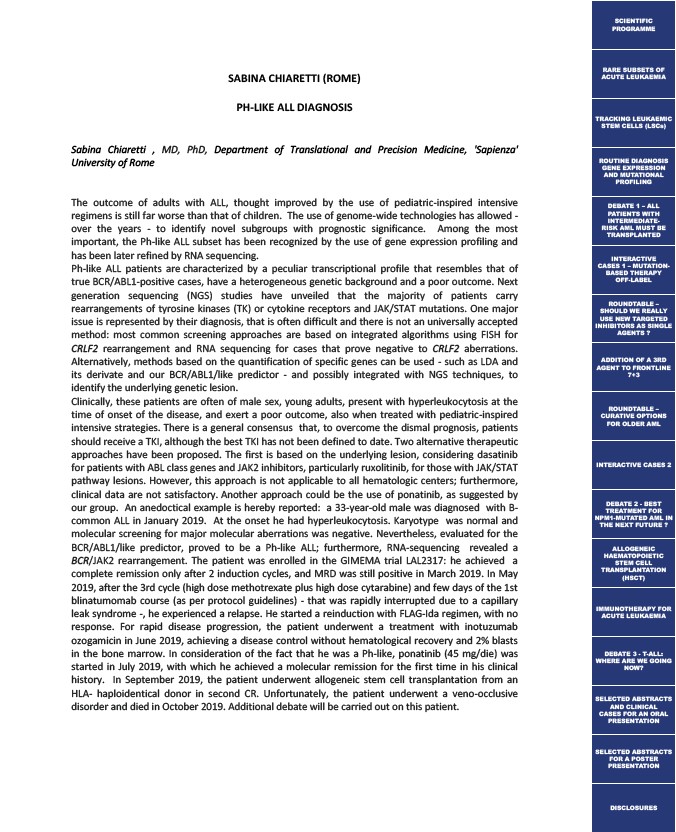
SABINA CHIARETTI (ROME)
PH-LIKE ALL DIAGNOSIS
Sabina Chiaretti , MD, PhD, Department of Translational and Precision Medicine, 'Sapienza'
University of Rome
The outcome of adults with ALL, thought improved by the use of pediatric-inspired intensive
regimens is still far worse than that of children. The use of genome-wide technologies has allowed -
over the years - to identify novel subgroups with prognostic significance. Among the most
important, the Ph-like ALL subset has been recognized by the use of gene expression profiling and
has been later refined by RNA sequencing.
Ph-like ALL patients are characterized by a peculiar transcriptional profile that resembles that of
true BCR/ABL1-positive cases, have a heterogeneous genetic background and a poor outcome. Next
generation sequencing (NGS) studies have unveiled that the majority of patients carry
rearrangements of tyrosine kinases (TK) or cytokine receptors and JAK/STAT mutations. One major
issue is represented by their diagnosis, that is often difficult and there is not an universally accepted
method: most common screening approaches are based on integrated algorithms using FISH for
CRLF2 rearrangement and RNA sequencing for cases that prove negative to CRLF2 aberrations.
Alternatively, methods based on the quantification of specific genes can be used - such as LDA and
its derivate and our BCR/ABL1/like predictor - and possibly integrated with NGS techniques, to
identify the underlying genetic lesion.
Clinically, these patients are often of male sex, young adults, present with hyperleukocytosis at the
time of onset of the disease, and exert a poor outcome, also when treated with pediatric-inspired
intensive strategies. There is a general consensus that, to overcome the dismal prognosis, patients
should receive a TKI, although the best TKI has not been defined to date. Two alternative therapeutic
approaches have been proposed. The first is based on the underlying lesion, considering dasatinib
for patients with ABL class genes and JAK2 inhibitors, particularly ruxolitinib, for those with JAK/STAT
pathway lesions. However, this approach is not applicable to all hematologic centers; furthermore,
clinical data are not satisfactory. Another approach could be the use of ponatinib, as suggested by
our group. An anedoctical example is hereby reported: a 33-year-old male was diagnosed with B-common
ALL in January 2019. At the onset he had hyperleukocytosis. Karyotype was normal and
molecular screening for major molecular aberrations was negative. Nevertheless, evaluated for the
BCR/ABL1/like predictor, proved to be a Ph-like ALL; furthermore, RNA-sequencing revealed a
BCR/JAK2 rearrangement. The patient was enrolled in the GIMEMA trial LAL2317: he achieved a
complete remission only after 2 induction cycles, and MRD was still positive in March 2019. In May
2019, after the 3rd cycle (high dose methotrexate plus high dose cytarabine) and few days of the 1st
blinatumomab course (as per protocol guidelines) - that was rapidly interrupted due to a capillary
leak syndrome -, he experienced a relapse. He started a reinduction with FLAG-Ida regimen, with no
response. For rapid disease progression, the patient underwent a treatment with inotuzumab
ozogamicin in June 2019, achieving a disease control without hematological recovery and 2% blasts
in the bone marrow. In consideration of the fact that he was a Ph-like, ponatinib (45 mg/die) was
started in July 2019, with which he achieved a molecular remission for the first time in his clinical
history. In September 2019, the patient underwent allogeneic stem cell transplantation from an
HLA- haploidentical donor in second CR. Unfortunately, the patient underwent a veno-occlusive
disorder and died in October 2019. Additional debate will be carried out on this patient.
SCIENTIFIC
PROGRAMME
RARE SUBSETS OF
ACUTE LEUKAEMIA
TRACKING LEUKAEMIC
STEM CELLS (LSCs)
ROUTINE DIAGNOSIS
GENE EXPRESSION
AND MUTATIONAL
PROFILING
DEBATE 1 – ALL
PATIENTS WITH
INTERMEDIATE-RISK
AML MUST BE
TRANSPLANTED
INTERACTIVE
CASES 1 – MUTATION-BASED
THERAPY
OFF-LABEL
ROUNDTABLE –
SHOULD WE REALLY
USE NEW TARGETED
INHIBITORS AS SINGLE
AGENTS ?
ADDITION OF A 3RD
AGENT TO FRONTLINE
7+3
ROUNDTABLE –
CURATIVE OPTIONS
FOR OLDER AML
INTERACTIVE CASES 2
DEBATE 2 - BEST
TREATMENT FOR
NPM1-MUTATED AML IN
THE NEXT FUTURE ?
ALLOGENEIC
HAEMATOPOIETIC
STEM CELL
TRANSPLANTATION
(HSCT)
IMMUNOTHERAPY FOR
ACUTE LEUKAEMIA
DEBATE 3 - T-ALL:
WHERE ARE WE GOING
NOW?
SELECTED ABSTRACTS
AND CLINICAL
CASES FOR AN ORAL
PRESENTATION
SELECTED ABSTRACTS
FOR A POSTER
PRESENTATION
DISCLOSURES